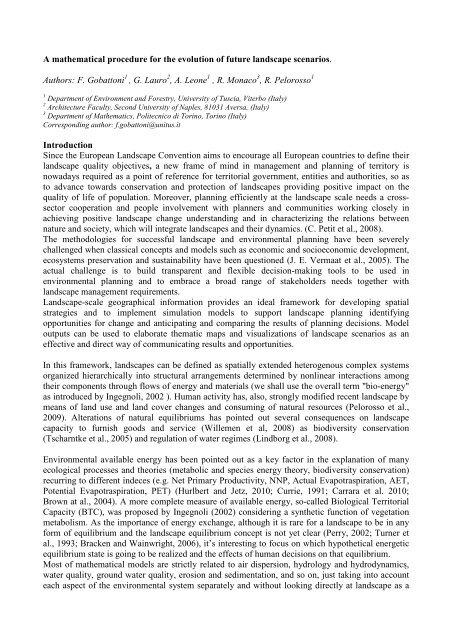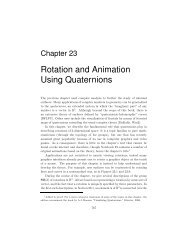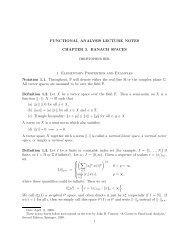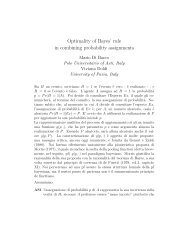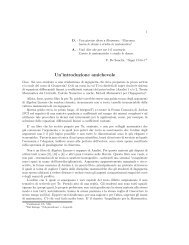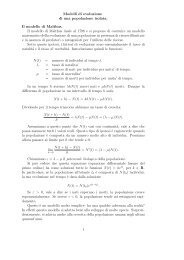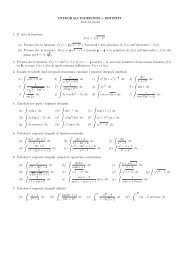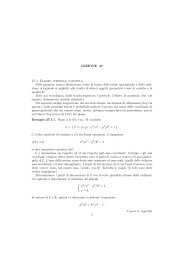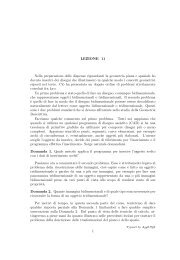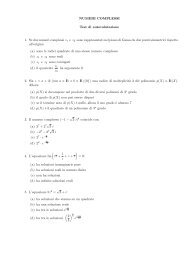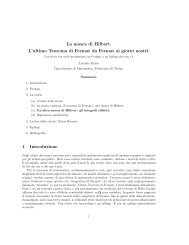j - Dipartimento di Matematica - Politecnico di Torino
j - Dipartimento di Matematica - Politecnico di Torino
j - Dipartimento di Matematica - Politecnico di Torino
You also want an ePaper? Increase the reach of your titles
YUMPU automatically turns print PDFs into web optimized ePapers that Google loves.
A mathematical procedure for the evolution of future landscape scenarios.<br />
Authors: F. Gobattoni 1 , G. Lauro 2 , A. Leone 1 , R. Monaco 3 , R. Pelorosso 1<br />
1 Department of Environment and Forestry, University of Tuscia, Viterbo (Italy)<br />
2 Architecture Faculty, Second University of Naples, 81031 Aversa, (Italy)<br />
3 Department of Mathematics, <strong>Politecnico</strong> <strong>di</strong> <strong>Torino</strong>, <strong>Torino</strong> (Italy)<br />
Correspon<strong>di</strong>ng author: f.gobattoni@unitus.it<br />
Introduction<br />
Since the European Landscape Convention aims to encourage all European countries to define their<br />
landscape quality objectives, a new frame of mind in management and planning of territory is<br />
nowadays required as a point of reference for territorial government, entities and authorities, so as<br />
to advance towards conservation and protection of landscapes provi<strong>di</strong>ng positive impact on the<br />
quality of life of population. Moreover, planning efficiently at the landscape scale needs a crosssector<br />
cooperation and people involvement with planners and communities working closely in<br />
achieving positive landscape change understan<strong>di</strong>ng and in characterizing the relations between<br />
nature and society, which will integrate landscapes and their dynamics. (C. Petit et al., 2008).<br />
The methodologies for successful landscape and environmental planning have been severely<br />
challenged when classical concepts and models such as economic and socioeconomic development,<br />
ecosystems preservation and sustainability have been questioned (J. E. Vermaat et al., 2005). The<br />
actual challenge is to build transparent and flexible decision-making tools to be used in<br />
environmental planning and to embrace a broad range of stakeholders needs together with<br />
landscape management requirements.<br />
Landscape-scale geographical information provides an ideal framework for developing spatial<br />
strategies and to implement simulation models to support landscape planning identifying<br />
opportunities for change and anticipating and comparing the results of planning decisions. Model<br />
outputs can be used to elaborate thematic maps and visualizations of landscape scenarios as an<br />
effective and <strong>di</strong>rect way of communicating results and opportunities.<br />
In this framework, landscapes can be defined as spatially extended heterogenous complex systems<br />
organized hierarchically into structural arrangements determined by nonlinear interactions among<br />
their components through flows of energy and materials (we shall use the overall term "bio-energy"<br />
as introduced by Ingegnoli, 2002 ). Human activity has, also, strongly mo<strong>di</strong>fied recent landscape by<br />
means of land use and land cover changes and consuming of natural resources (Pelorosso et al.,<br />
2009). Alterations of natural equilibriums has pointed out several consequences on landscape<br />
capacity to furnish goods and service (Willemen et al, 2008) as bio<strong>di</strong>versity conservation<br />
(Tscharntke et al., 2005) and regulation of water regimes (Lindborg et al., 2008).<br />
Environmental available energy has been pointed out as a key factor in the explanation of many<br />
ecological processes and theories (metabolic and species energy theory, bio<strong>di</strong>versity conservation)<br />
recurring to <strong>di</strong>fferent indeces (e.g. Net Primary Productivity, NNP, Actual Evapotraspiration, AET,<br />
Potential Evapotraspiration, PET) (Hurlbert and Jetz, 2010; Currie, 1991; Carrara et al. 2010;<br />
Brown at al., 2004). A more complete measure of available energy, so-called Biological Territorial<br />
Capacity (BTC), was proposed by Ingegnoli (2002) considering a synthetic function of vegetation<br />
metabolism. As the importance of energy exchange, although it is rare for a landscape to be in any<br />
form of equilibrium and the landscape equilibrium concept is not yet clear (Perry, 2002; Turner et<br />
al., 1993; Bracken and Wainwright, 2006), it’s interesting to focus on which hypothetical energetic<br />
equilibrium state is going to be realized and the effects of human decisions on that equilibrium.<br />
Most of mathematical models are strictly related to air <strong>di</strong>spersion, hydrology and hydrodynamics,<br />
water quality, ground water quality, erosion and se<strong>di</strong>mentation, and so on, just taking into account<br />
each aspect of the environmental system separately and without looking <strong>di</strong>rectly at landscape as a


